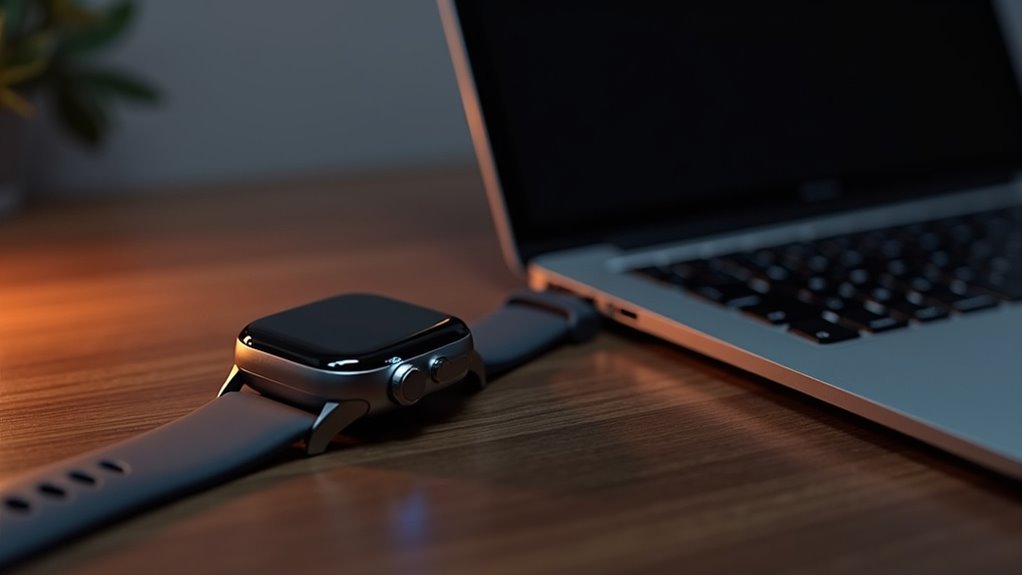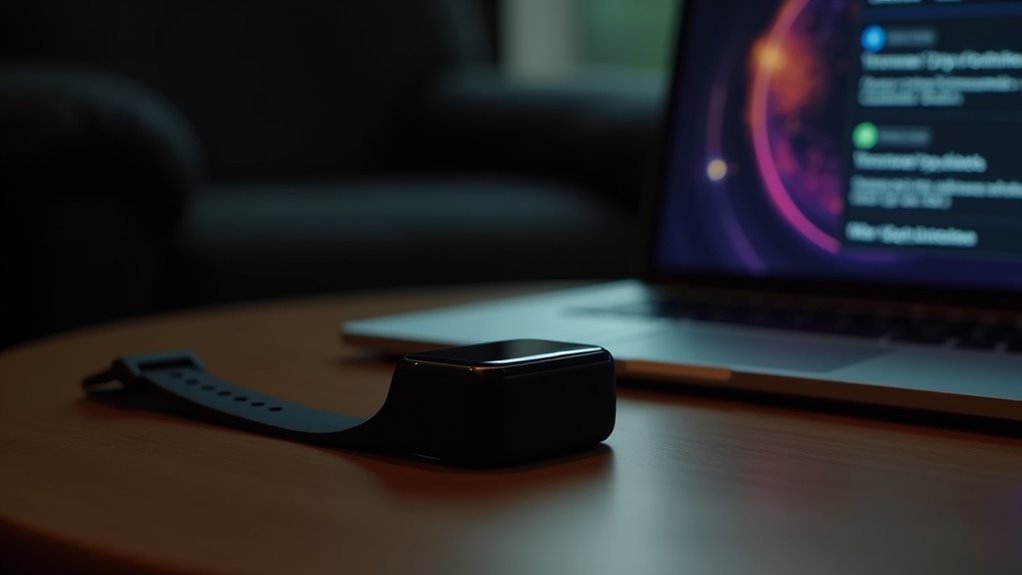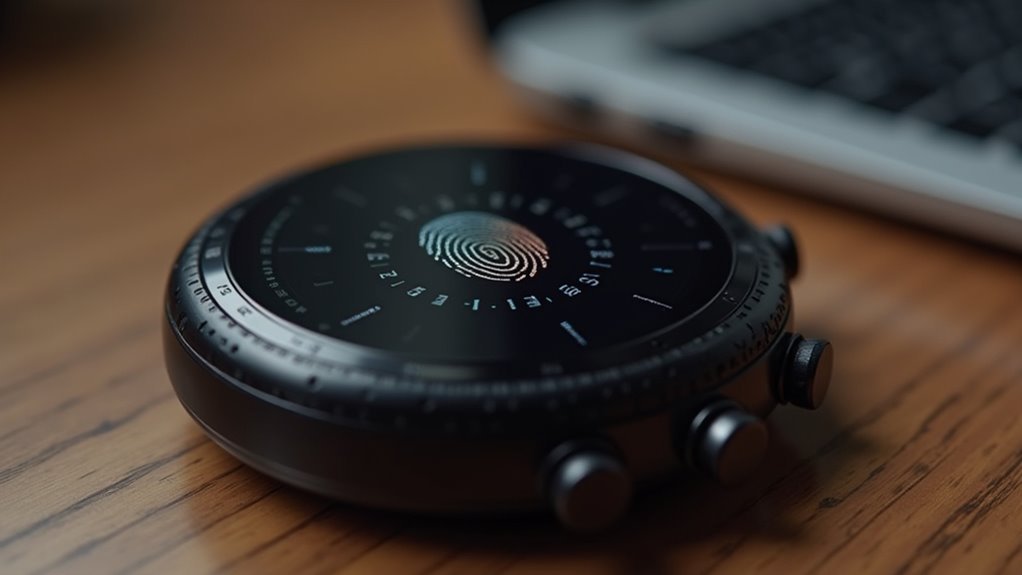Your wearable’s fingerprint scanner needs thorough protection through hardware-based AES-256 encryption, Trusted Execution Environments that isolate biometric processing, and tamper-resistant designs with secure boot verification. You’ll want multifactor authentication integration, regular firmware updates, and GDPR-compliant data minimization techniques that store only essential fingerprint templates. Strong passcode backup authentication, automatic session timeouts, industry certifications like ISO 27001, and robust incident response planning complete your security framework. These layered safeguards work together to create an impenetrable defense system.
Hardware Encryption and Trusted Execution Environment Protection

When you implement fingerprint scanning on wearable devices, hardware encryption serves as the foundational layer protecting your biometric data from unauthorized access.
AES encryption offers the ideal balance of strong security and efficiency for your smartwatch or fitness tracker, while ECC provides robust protection with shorter key lengths that won’t drain your device’s resources.
AES and ECC encryption technologies deliver optimal security-to-performance ratios, ensuring your wearable device stays protected without compromising battery life or processing speed.
Your wearable’s Trusted Execution Environment creates a secure zone within the main processor, isolating fingerprint processing from the standard operating system.
This trusted area executes cryptographic functions and handles encryption keys in a hardened environment that’s inaccessible to malicious apps or firmware.
TEE considerably reduces attack surfaces by maintaining the integrity and confidentiality of your biometric data during authentication processes.
Traditional encryption methods face significant vulnerabilities as quantum computing can perform calculations much faster than classical computers, making quantum-resistant algorithms increasingly important for future-proofing your wearable’s security architecture.
Tamper-Resistant Design and Secure Boot Verification
Beyond software protections, your wearable device’s physical security depends on tamper-resistant hardware architecture that shields critical components from unauthorized access. Your device’s fingerprint sensor and microcontroller sit within protective casings that detect intrusion attempts and trigger automatic responses.
| Security Layer | Protection Method |
|---|---|
| Hardware Architecture | Tamper-resistant casings with detect circuits |
| Root of Trust | Immutable hardware-based verification anchor |
| Boot Verification | Cryptographic signature validation chain |
| Tamper Response | Automatic sensor disable and key erasure |
Your device’s secure boot process verifies each firmware stage using cryptographic signatures before execution. An immutable Root of Trust anchored in hardware guarantees only authenticated firmware loads. The firmware validates each software component against predefined keys stored in secure memory during the boot sequence. When tampering occurs, your device automatically disables the fingerprint sensor and erases sensitive keys, creating an impenetrable barrier against physical attacks.
Regular Firmware Updates and Vulnerability Patching

You’ll need to establish automated update scheduling to guarantee your wearable device receives critical security patches without delay.
Your device’s firmware contains vulnerabilities that hackers can exploit to access your biometric data, making timely updates essential for protecting your fingerprint scans.
You should prioritize security patches over feature updates, as these defensive improvements directly safeguard your personal authentication data from emerging cyber threats. Research-grade wearables with FDA clearance typically undergo more rigorous security protocols than consumer devices, offering enhanced protection for sensitive biometric information.
Automated Update Scheduling
As your wearable device connects to networks and processes sensitive fingerprint data, automated update scheduling becomes your most reliable defense against evolving security threats. You’ll want to schedule updates during low-usage periods while guaranteeing stable Wi-Fi connectivity and adequate battery levels.
| Update Component | Security Benefit |
|---|---|
| Encryption Algorithms | Strengthens fingerprint data protection |
| Authentication Protocols | Prevents unauthorized access attempts |
| Vulnerability Patches | Closes known security exploits |
| Biometric Scanning | Improves recognition accuracy |
| Network Communications | Secures data transmission channels |
You should enable automatic backups before updates and implement fallback mechanisms for failed installations. Digital signature verification guarantees update authenticity, while detailed logging helps track security improvements. Monthly updates provide a recommended frequency for maintaining optimal security posture while balancing system stability with threat protection. This approach minimizes exposure windows and maintains compliance with biometric data regulations.
Security Patch Prioritization
When security vulnerabilities emerge in wearable devices, you must establish a systematic approach to patch prioritization that addresses the most critical threats first.
You’ll need to focus on vulnerabilities that expose sensitive biometric, location, or health data, as these carry the highest impact if exploited. Implement risk scoring systems to balance threat severity against your device’s limited capabilities and processing constraints.
Don’t overlook third-party libraries in your firmware—they’re increasingly targeted by attackers and require urgent attention.
You should maintain continuous automated monitoring to detect new exploits quickly, as threats evolve rapidly in the wearable space. Real-time monitoring paired with AI algorithms can significantly enhance your ability to identify suspicious activities before they escalate into major security breaches.
Ascertain your patch deployment strategy aligns with regulatory compliance requirements for biometric and health data security, while establishing clear update protocols that communicate urgency to users effectively.
Multifactor Authentication Integration With Access Controls
Integrating fingerprint-enabled wearables into multifactor authentication frameworks transforms how you’ll secure access to enterprise systems and sensitive data.
These devices seamlessly connect with major Identity and Access Management platforms, enabling rapid deployment within your existing access control infrastructure. You’ll benefit from FIDO2-compliant passwordless authentication that eliminates phishing vulnerabilities while maintaining user-friendly operation.
Your wearable’s biometric credentials are stored in hardware-certified secure elements with EAL5+ certification, ensuring maximum protection. These solutions address critical authentication challenges for battery-operated devices by optimizing energy consumption while maintaining security effectiveness.
Continuous authentication capabilities verify your identity persistently, mitigating risks from device theft or unauthorized use. The combination of fingerprint scanning with behavioral and contextual factors creates robust verification that adapts to evolving security requirements through upgradeable firmware, giving you granular permission controls across enterprise environments.
Advanced Data Encryption Using AES-256 Standards

When you’re securing fingerprint data on wearable devices, AES-256 encryption transforms your biometric information through a sophisticated process that scrambles data into unreadable code using 256-bit keys.
You’ll need robust storage protection methods that safeguard this encrypted data both in your device’s memory and during idle states.
Your wearable also requires transmission security protocols that maintain AES-256 encryption standards when sending fingerprint data to paired devices or cloud servers. This symmetric encryption approach ensures the same key that locks your biometric data can efficiently unlock it for authorized access.
AES-256 Encryption Process
As fingerprint data travels from your wearable device’s sensor to its secure storage, AES-256 encryption transforms this sensitive biometric information into an unbreakable digital fortress. This sophisticated process protects your unique identity markers through multiple security layers.
The encryption process systematically secures your data through these critical steps:
- Information Division: Your fingerprint data gets divided into 4×4 columns of 16-byte blocks for processing.
- Key Expansion: The initial 256-bit key expands into multiple round keys using Rijndael key schedule.
- Substituting Bytes: Non-linear substitution scrambles bytes within your data blocks.
- Row Shifting and Column Mixing: Rows shift and columns mix to create additional encryption complexity.
Through 14 encryption rounds, each applying substitution, transposition, and mixing operations, your fingerprint becomes computationally impossible to crack with current technology. The same secret key used for encryption enables authorized devices to decrypt and restore your original fingerprint data when verification is required.
Storage Protection Methods
Once your fingerprint data undergoes AES-256 encryption, your wearable device employs multiple storage protection methods to maintain this digital fortress.
Your device implements secure key storage protocols that prevent unauthorized access to encryption keys. It distributes secret keys before use through key pre-distribution methods, guaranteeing they’re never transmitted over vulnerable channels.
You’ll benefit from structured data encryption that adapts AES-256 specifically for biometric information storage. Your device stores encrypted fingerprint templates in segmented memory locations, creating additional barriers against potential breaches.
Regular key rotation and updates protect against evolving threats. Role-based access controls ensure that only authorized healthcare personnel can access your biometric data when your wearable integrates with medical systems. These layered protection methods guarantee your biometric data remains secure even if your device falls into wrong hands, maintaining data integrity throughout storage periods.
Transmission Security Protocols
Your fingerprint data’s journey from device to cloud requires equally robust protection during transmission as it receives in storage. AES-256 encryption serves as the industry-standard defense, providing lightweight yet powerful security for your wearable device’s limited resources.
This advanced encryption standard offers several key advantages for fingerprint transmission:
- Pre-distributed secret keys guarantee only authorized cloud servers can decrypt your biometric data.
- Packet-level encryption secures individual data transmissions from your wearable to prevent interception.
- Timestamp integration prevents replay attacks and unauthorized data resends.
- Resource efficiency maintains battery life while delivering enterprise-grade security comparable to healthcare systems.
Unlike computationally heavy alternatives like RSA, AES-256’s 256-bit key length provides long-term resilience against brute-force attacks without compromising your device’s performance.
Secure Communication Channels and Encrypted Backups
Three critical vulnerabilities threaten your wearable fingerprint scanner’s data security: wireless signal interception, unencrypted data transmission, and compromised backup storage.
You’ll need encrypted Bluetooth Low Energy and HTTPS protocols to protect your transmitted data, though implementation challenges remain on resource-constrained wearables.
Consider electro-quasistatic human body communication (EQS-HBC) since it confines signals close to your body, dramatically reducing interception risks compared to traditional radio waves.
EQS-HBC technology keeps your biometric signals confined to your body’s surface, making wireless eavesdropping nearly impossible for potential attackers.
For backups, you should implement zero-knowledge encryption models that prevent cloud providers from accessing your decrypted fingerprint data.
Use AES-256 encryption with rotating session keys and multi-factor authentication. Your backup strategy must include periodic audits and geographically distributed servers. Recent data breaches affecting fitness tracking apps demonstrate how vulnerable personal information becomes when multiple devices sync without proper security protocols.
Don’t forget mutual authentication between devices to prevent man-in-the-middle attacks during data exchanges.
GDPR, CCPA, and BIPA Legal Compliance Requirements
When your wearable fingerprint scanner touches a user’s skin, it triggers a complex web of legal obligations spanning multiple jurisdictions.
You’ll need to navigate three critical frameworks governing biometric data protection.
Under GDPR, you must obtain explicit consent for processing fingerprint data as a special category requiring enhanced safeguards.
You’re required to implement data minimization principles and robust security measures while providing transparent information about processing purposes. Processing must be necessary and proportionate to achieve the overall purpose, as reliance on lawful bases cannot be arbitrary.
CCPA grants consumers specific rights regarding their biometric information:
- Right to access collected fingerprint data
- Right to request deletion of stored biometric information
- Right to opt-out of data sales or sharing
- Right to receive clear collection notices
BIPA demands written consent before collecting fingerprints, prohibits profiting from biometric data, and creates private lawsuit rights with statutory damages.
Strong Passcode Integration and Session Timeout Features
Although fingerprint authentication provides robust security on its own, integrating it with strong passcode systems creates a formidable dual-layer defense for wearable devices. You’ll benefit from dual-factor authentication that notably enhances your overall security compared to traditional single-method approaches.
Your wearable’s session timeout features automatically log you out after inactivity periods, preventing unauthorized access. Continuous biometric monitoring guarantees your session remains authenticated only while you’re present. When your fingerprint data no longer matches or times out, the session automatically terminates. Current regulatory frameworks must evolve to address the unique security challenges that wearable devices present in protecting biometric data.
| Security Feature | Benefit |
|---|---|
| Dual-factor authentication | Enhanced protection beyond single methods |
| Continuous monitoring | Real-time user presence verification |
| Automatic session termination | Prevents unauthorized access during absence |
| Secure data storage | Certified secure elements protect fingerprint data |
| Gesture authentication | Deliberate user verification reduces false timeouts |
You’ll find these integrated systems maintain security without disrupting your workflow.
Data Minimization and Pseudonymization Techniques
You’ll want to collect only the fingerprint data that’s absolutely necessary for authentication, avoiding unnecessary biometric details that increase your privacy risk.
Separate your actual identity from the stored fingerprint templates using pseudonymization methods that disconnect your personal information from the biometric data.
Implement storage reduction strategies that limit how much fingerprint data remains on your wearable device, keeping only essential authentication markers while discarding redundant information. Remember that biometric data cannot be changed like passwords if compromised, making protective measures even more critical for long-term security.
Minimal Data Collection
While fingerprint scanning on wearables offers enhanced security, it’s essential that these devices collect only the data they absolutely need to function effectively.
You should evaluate what biometric information is truly necessary for authentication and device functionality.
When implementing minimal data collection for fingerprint-enabled wearables, focus on these key practices:
- Limit scan frequency – Only capture fingerprint data when authentication is required
- Reduce template storage – Store minimal biometric templates rather than full fingerprint images
- Implement selective processing – Process only essential fingerprint features needed for verification
- Enable user controls – Provide options to adjust data collection based on your privacy preferences
You’ll maintain better privacy protection while ensuring your wearable device functions securely. Organizations must also conduct Data Protection Impact Assessments to identify potential privacy risks before deploying fingerprint scanning features in their wearable devices.
This approach aligns with GDPR compliance requirements and reduces potential privacy risks associated with excessive biometric data collection.
Identity Separation Methods
When you implement fingerprint scanning on wearables, protecting user identity becomes essential through strategic separation methods that disconnect biometric data from personal identifiers.
Data minimization guarantees you collect only necessary fingerprint data, reducing breach risks while simplifying management. You’ll need careful planning to balance functionality with privacy protection.
Pseudonymization replaces your personally identifiable information with artificial identifiers, using techniques like tokenization, encryption, or hash functions.
Wearable devices can utilize cryptographic methods to transform fingerprint data into secure, non-identifiable forms. You should choose between one-way or two-way tokens based on whether reversibility is needed.
Proper key management prevents unauthorized access, while regulatory compliance guarantees your implementation meets privacy requirements like GDPR standards for biometric data protection. Implementing micro-databases for individual users creates separately encrypted data containers that enhance protection while maintaining analytical capabilities.
Storage Reduction Strategies
Building on these identity separation methods, storage reduction strategies form the next layer of protection by fundamentally limiting how much fingerprint data you store and how it’s formatted.
You’ll achieve this through two primary approaches: data minimization and pseudonymization techniques.
Data minimization means you’ll collect only essential biometric data needed for your device’s specific functions.
You should:
- Store processed templates instead of raw fingerprint images
- Set automatic deletion periods for operational data
- Process data locally on your wearable to avoid external transmission
- Apply purpose limitation principles under GDPR compliance
Pseudonymization replaces your identifiable fingerprint data with unique codes, breaking direct links to your identity.
You’ll store pseudonymous data separately from identification keys while implementing cryptographic methods for dynamic pseudonym generation. Proper encryption techniques ensure that even if biometric templates are accessed, they remain protected from unauthorized interpretation and misuse.
Industry Certification Standards and Incident Response Planning
As wearable technology integrates fingerprint scanning capabilities, you’ll need to navigate a complex landscape of industry certification standards that guarantee both device safety and biometric data protection. UL certification guarantees electrical safety, while HIPAA compliance becomes mandatory when handling Protected Health Information. You must also meet EMC and RF standards for proper device functioning.
| Standard | Focus Area | Key Requirement |
|---|---|---|
| UL Certification | Electrical Safety | Battery and biometric safeguards |
| GDPR/CCPA | Data Privacy | Secure storage and transmission |
| ISO 27001 | Security Management | Information security protocols |
| FCC IoT | Cybersecurity | Voluntary secure practices |
Your incident response planning should include encrypted data storage, secure communication protocols, multi-factor authentication, and regular firmware updates with digital signatures to maintain device integrity. Manufacturers must also consider global market access requirements, as regulations vary significantly between medical devices and wellness products across different regions.
Frequently Asked Questions
Can Fingerprint Data Be Recovered if My Wearable Device Gets Damaged?
Most wearables don’t store your fingerprint data locally – they rely on your paired smartphone for authentication. If your wearable’s damaged, you likely won’t lose fingerprint data since it’s stored elsewhere.
How Long Does My Fingerprint Data Remain Stored on the Device?
Your fingerprint data remains stored indefinitely on your wearable device until you manually delete it or perform a factory reset. There’s no automatic expiration or deletion policy.
What Happens to My Biometric Data if I Sell My Wearable?
When you sell your wearable, you legally own the biometric data and should delete it completely before transferring the device. Without proper data wiping, buyers could access your sensitive information.
Can Law Enforcement Access My Fingerprint Data Without My Permission?
Law enforcement can access your fingerprint data with proper legal authority like warrants or court orders. They can also compel you to gain access to devices using fingerprints during lawful searches without violating Fifth Amendment rights.
Do Fitness Apps Have Access to My Stored Fingerprint Information?
Fitness apps typically don’t access your stored fingerprint data. Your fingerprints are secured at the device level with encrypted storage and limited access, requiring your explicit consent for any sharing.
In Summary
You’ll protect your wearable device’s fingerprint data by implementing these ten safeguards consistently. Don’t overlook hardware encryption, tamper-resistant designs, or regular firmware updates. You’re ensuring compliance with privacy laws while maintaining strong authentication protocols. Remember, you can’t afford to skip data minimization or incident response planning. Your device’s security depends on combining all these elements effectively. Stay vigilant about monitoring vulnerabilities and updating your security measures as threats evolve in wearable technology.





Leave a Reply